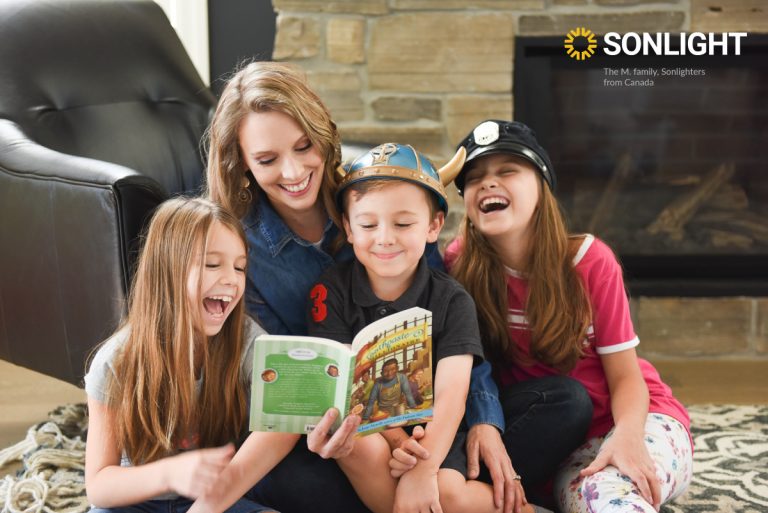While many children seem to naturally understand the skills that go along with listening to stories, it is not a skill that all children intuitively learn. Since Sonlight is a literature-rich program, developing listening skills is as important as developing reading or writing skills. When we feed children information or teach them to read for it, it can get harder for them to listen for it. But being able to hear and understand is an essential skill.
Determine if Listening Skill Is the Issue
Sonlight tends to use books that are interesting and engaging wherever possible. But because not all children develop in the same areas at the same pace, a child who is ahead in reading might need more time to work on math skills. Or a child who is ahead in science might not do as well with history. It’s important, then, to determine if the issue you are having with your child is their ability to listen to stories or if the material they are listening to is simply a little bit more advanced than they are currently ready for.
There is nothing wrong with a child who isn’t quite ready yet. It simply means his or her brain might have been more devoted to sports or singing skills or math ability, and hasn’t quite caught up in listening or vocabulary quite yet. Being at different levels in different subjects or activities (asynchronous) is very normal for children, and, barring learning disorders, they usually catch up when their brain is ready to.
In the meantime, if you seem to notice your child is having trouble listening to most of what you are reading to her or him, then you might simply be working one level above their current ability. Dropping back a level will allow their brain time to develop.
But if your child is having trouble concentrating on one type of book, or at certain times of day, or sometimes does well and sometimes doesn’t, then the problem might be they have trouble listening.
Teaching Them to Pay Attention
First, make sure your child is paying attention. She may be zoning out. Stop every few sentences and ask a question about the last thing you read to see if she is listening. If she does well, extend the time between questions. For example, if I read, "John put on his red coat and went outside," I could ask "What color coat did he wear?" Between reading aloud and asking the question, I try to not change my tempo or voice to see if they are really listening.
If your child has trouble with this, do it often. Knowing you will expect it often will help his brain get used to listening for your questions, and then, get used to listening for the information in the story that might become a question, and by default, get used to listening to everything else.
Teaching Comprehension
When you believe your child is listening to the words well and is hearing what you are reading, it’s easy to transition into teaching overall comprehension. Every time you finish a daily Reader or Read-Aloud passage, ask "What are three things you learned from this chapter," or, "Tell me three things you remember about this." Let her choose any three things.
Compliment her on her choices and discuss them if you’d like. Then, respond with "The three most important things to me from this chapter were…” and then insert a good summary or narration of the passage. You might need to let your child know that you chose different key highlights because of things you remember from your past or things you found interesting, and that it’s okay if your 3 items are different from his.
If your child struggles to come up with three items, try having them find just one the first days, and then increasing up to two after a month or two, and slowly building up to three.
If your student struggles with either comprehension or listening ability, consider having him or her tested for an auditory processing disorder. They might be hearing well, but it might not be making all the connections in their brain.
You might need to combine teaching comprehension with continuing work on building listening skills for a few months.
Let Your Child Stim While Listening
While stimming (self-stimulating) behaviors (actions where your child uses repetitive movements or sounds to help them concentrate or adapt) is often found in some developmental disorders, we all self-stimulate to some degree. Whether it’s doodling on a pad of paper while listening to a lecture, or twirling our hair while on the phone, or even knitting during church service, certain behaviors help us to listen better by distracting the brain from other distractions.
Children also sometimes need to keep their hands or bodies busy while listening if they want to listen better. Other children just struggle to focus if they are quiet and still, and while seemingly contradictory, learn faster and better when their bodies are in motion. Here are many ways you can keep your child’s body in motion while listening to read-alouds.
But, watch for patterns. Other children will struggle to listen if there is too much movement or noise, and need to be quiet and sitting still to listen at their best.
Teach Your Child to Want to Listen
We’ve all heard boring speakers or watched documentaries that put us to sleep. Our brain is not equally engaged or excited about listening to all topics equally. There are times when listening to something is much harder work than it ought to be. When that happens, incentivize your children to listen. Offer him something to reward him for working at something hard for him, whether it be stickers or earning points toward a trip to the store, or extra screen time.
Give him a reason to want to listen.
Children are often eager learners, so learning how to listen doesn’t take most children very long, although you will find some who would rather be doing anything else rather than listening. However, teaching listening skills should gradually increase over time, and you might need to start at a lower level to really solidify those skills before moving on. In time, with continued use of a literature-rich program that uses the engaging, imagination-sparking books that Sonlight uses, will help your children to be better listeners in general, as well as better at grasping and learning information through a variety of input methods.
Celebrate World Read-Aloud Day 2022 with Sonlight! And enter to win prizes!











Thank you for this article. I homeschool my daughter and when I see her doodling while watching her videos I assume that she isn’t paying attention, now I understand!